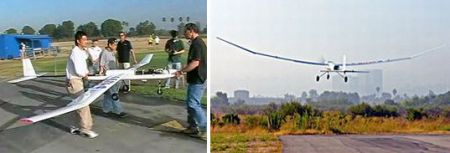
A fuel cell-powered remotely piloted aircraft buzzed quietly into the morning sky in a park near Van Nuys, Calif., August 25. The unorthodox flight was a triumph of collegiate innovation made possible by a nurturing program at California State University Los Angeles and a boost from NASA’s Academic Investments Office and the Air Force Office of Scientific Research. Rapidly emerging fuel-cell-power technologies may be used to launch a new revolution of electric propulsion systems for light aircraft. Future small electric airplanes using fuel cell technologies hold the promise of high reliability, low maintenance, low noise, and with the exception of water vapor zero emissions.
The above mentioned aircraft has a highly efficient shape that allows for a wing with a high lift to drag ratio. With an 18 foot span, the wings have a high aspect ratio and help to provide the most lift with a minimum amount of drag. This was important to the design of the UAV because the fuel cell power plant has a low power to weight ratio.
In the future, aircraft pilots may not have to rely solely on their jet fuel to power their planes. They could turn to fuel cells to power at least some onboard systems. Hydrogen fuel cells like those developed for automobiles produce water vapor as a byproduct of generating power. Hydrogen and fuel cell power technologies have now reached the point where they can be exploited to initiate a new era of propulsion systems for light aircrafts and small commuter aircrafts.
Via: Makezine




